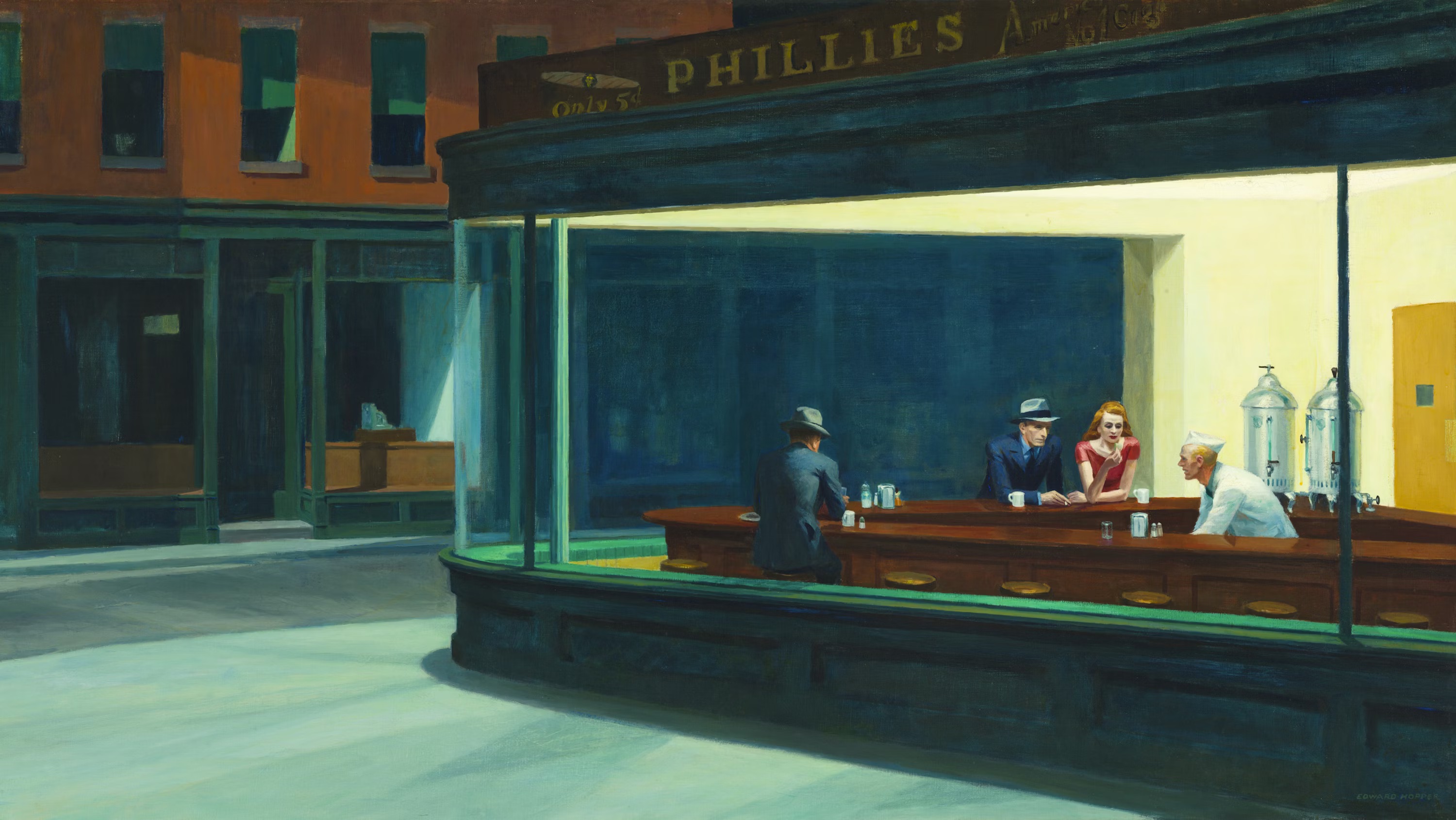Nighthawks (1942) is an oil painting on canvas by Edward Hopper. The work depicts three customers and an attendant in a glass-walled diner situated on a city corner late at night. The figures do not interact with one another, while the exterior space is portrayed as empty and dark. The composition is built upon the contrast between the artificial brightness of the interior light and the surrounding darkness. According to Hopper, the subject of the painting reflects the sense of loneliness in a large city.【1】
Creation Process and Provenance
Nighthawks was completed by Edward Hopper in the early months of 1942 after about six weeks of intense work. The artist’s wife, Jo Hopper, served as the model for the female figure, while Hopper himself used his reflection in a mirror as a reference for the two male figures. Throughout the painting process, Hopper remained consistently focused on the work, channeling his detachment from contemporary social developments into this period of creative productivity.
Shortly after its completion, in May 1942, the painting was purchased by the Art Institute of Chicago through the Frank K. M. Rehn Gallery. The museum financed the acquisition by deaccessioning Hopper’s earlier work Compartment C, Car 293. The painting remains in the Art Institute of Chicago’s collection today and is preserved as part of the Friends of American Art Collection gift. Admired even during Hopper’s lifetime, Nighthawks quickly became the artist’s most recognized and frequently referenced work.

Nighthawks, Edward Hopper (The Art Institute of Chicago)
Technical Features
Nighthawks was executed in oil on canvas. The painting measures 84.1 × 152.4 cm (33 1/8 × 60 inches). In the lower right corner, the artist’s signature, “EDWARD HOPPER,” appears in green paint.
Hopper presents the scene with simplified forms and flat color surfaces, achieving an almost graphic clarity in the composition. The fluorescent light source illuminates the entire interior, enhancing the vividness of the colors and emphasizing the details. The perspective is constructed at an angle characteristic of New York’s diagonal street corners, allowing the figures to be viewed both frontally and in profile. Visual elements referring to the exterior space are extremely limited; there are no details such as trash, signs, or clocks on the street.
In terms of lighting and surface treatment, Hopper’s painting appears as polished and luminous as a commercial poster. The smooth transitions of color and the even texture of the surface, combined with the stillness of the figures, evoke a profound sense of calm and introspection in the viewer.
Composition and Thematic Structure
Nighthawks features a tightly organized geometric composition. The painting depicts three customers and a server inside a glass-walled corner diner. Although the figures are positioned facing one another, no communication takes place between them; any potential interaction is deliberately suspended by Hopper. The façade facing the viewer lacks an entrance door, meaning that the observer is included only as a spectator, unable to enter the space.
The artificial light source at the center of the composition illuminates the surrounding darkness, creating spatial depth while emphasizing the contrast between the interior and exterior worlds. Although the characters belong to the everyday life of the city, each is portrayed in isolation—no one looks at another, and there is no shared gesture or expression. This lack of interaction visually conveys what Hopper described as the “loneliness of a large city.”
The painting offers no clear narrative or sequence of events; instead, it invites the viewer to wonder who the figures are, where they might be going, and what they might be thinking. The anonymity of the characters and the abstracted nature of the diner transform the scene into something both timeless and universal. In this way, Hopper uses an ordinary urban setting to render a powerful representation of solitude.
Cultural Impact
After its purchase by the Art Institute of Chicago in 1942, Nighthawks reached a wide audience and became one of the most recognizable works in the museum’s collection. Although the setting and figures reflect visual elements characteristic of mid-20th-century America, the abstracted structure of the scene and the lack of interaction between the figures lend the painting a timeless quality.
Over time, the work has been referenced across various forms of cultural production, particularly in television, literature, and graphic arts, where it has been reinterpreted in diverse ways. The stillness of Hopper’s characters, the simplicity of the space, and the distinct use of light have been understood by audiences in different contexts and meanings.
The period-specific clothing of the figures and the details within the diner anchor the painting in a particular historical moment, while the isolation from the outside world and the absence of a clear narrative make it open to multiple interpretations. Because of these qualities, Nighthawks stands as a visual icon that transcends art history, maintaining a significant presence within popular culture through frequent references and reinterpretations.


